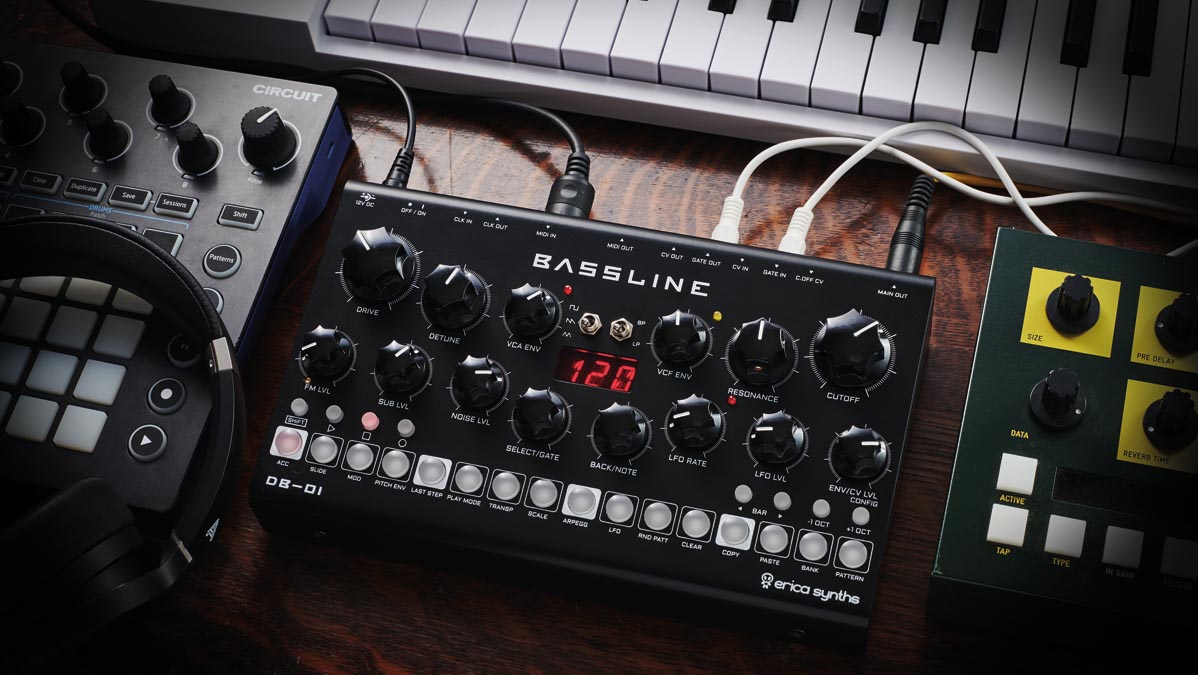MusicRadar Verdict
A powerful sequencer and plenty of unique features make this much more than just another Bassline-clone.
Pros
- +
Meaty, punchy sound with lots of grit!
- +
Surprisingly deep sequencer.
- +
Built-in pattern memory.
Cons
- -
Master volume is hidden amongst settings menus.
- -
We would have loved an audio in.
MusicRadar's got your back
What is it?
Latvian brand Erica Synths have proved quite prolific in recent years, delivering modules, systems and standalone hardware at a pace that’s tough to keep up with at times.
What’s impressive though, is that despite the volume, the quality has remained high. What Erica do especially well is analogue grit – from their Polivoks-inspired filters to their tube-equipped Fusion modules and last year’s impressive Ninja Tune collab Zen Delay, Erica are responsible for some of our favourite go-to tools for raw, edgy sounds.
Naturally, the idea of a standalone Erica-branded bass synth has got us rather hot under the collar. At first glance, you’d be forgiven for thinking the Bassline DB-01 was another 303 clone.
The marriage of analogue oscillators, Polivoks filter and gritty detune and drive make this an absolute beast
It does certainly bear many of the hallmarks of its near-namesake; the single oscillator, resonant filter and simplistic envelope controls are pure acid-machine. But beyond this there’s a lot of unique stuff going on that makes the DB-01 very much its own instrument.
Oscillators/Filters
On the oscillator front, the DB-01’s single VCO is switchable between square, saw and triangle waveshapes. This comes paired with a sub oscillator, fixed at tracking one octave below, and a noise generator, both of which have their own level controls.
The oscillator section also has a Detune control that emulates the unison effect of multiple detuned VCOs by using a pair of BBD lines as frequency shifters. The effect is pretty convincing, adding a nice thickness to sounds that I particularly like when using the DB-01 as a drone machine (more on this later).
The oscillator has a frequency modulation control too, which dials in modulation from the LFO. The LFO itself has a broad frequency range and a selection of five waveshapes, meaning the effect can range from subtle pitch drift through vibrato and into audio-rate pitch modulation.
It’s gritty and can sound nicely aggressive – with a resonant LPF rolled down low over a sub bass sound, the DB-01 can create some serious low-end weight
The DB-01’s fi lter, meanwhile, is the same Polivoks-inspired VCF found in Erica’s excellent Acidbox effect units. It’s switchable between two modes, 12db low-pass and 6db band-pass, with a resonance control capable of going into selfoscillation.
It’s gritty and can sound nicely aggressive – with a resonant LPF rolled down low over a sub bass sound, the DB-01 can create some serious low-end weight.
Modulation
Modulation of the amp and filter is provided by a pair of simple envelope generators.
The amp envelope is sustain-release design with just a single control for adjusting the decay time of the release stage. Turn it fully open and the release becomes infinite, letting the DB-01 act as a drone synth, which it’s surprisingly adept at, particularly once you throw in some slow modulation from the LFO and BBD detune effect.
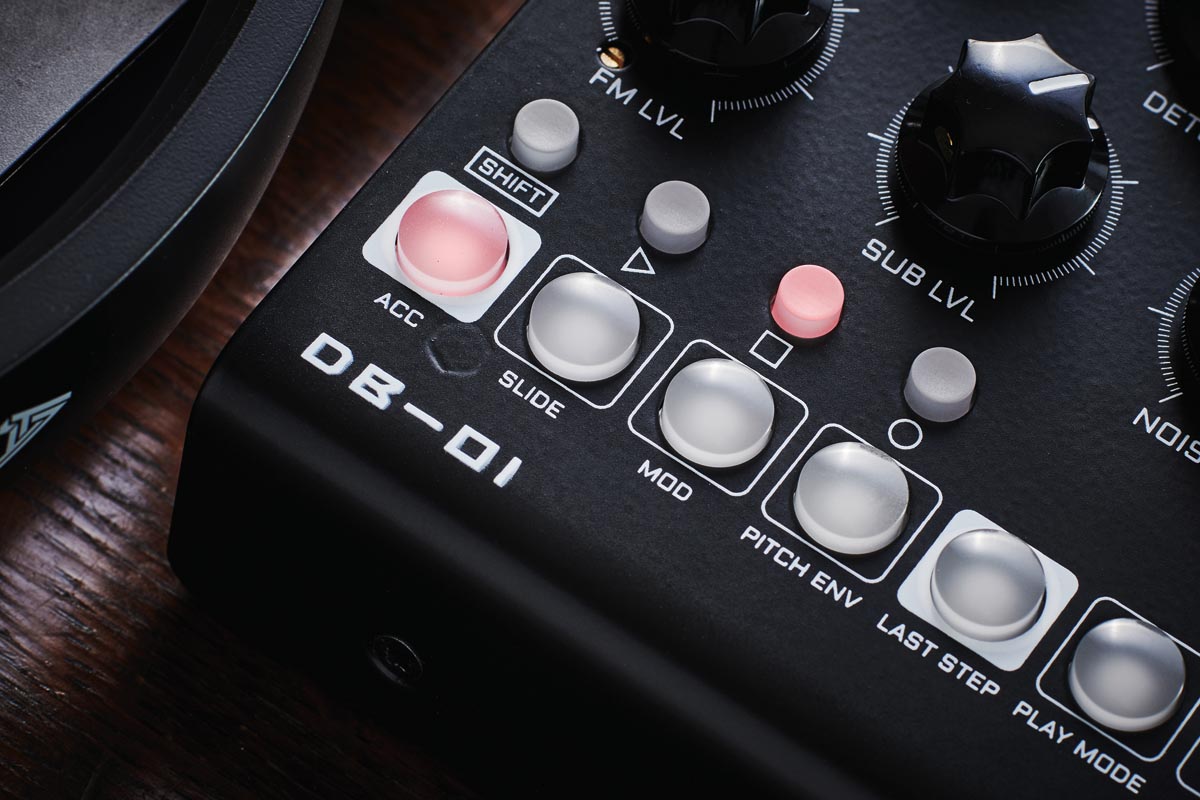
The filter envelope, meanwhile, is just a decay stage, with attack and sustain fixed at zero. Limited though they may be – and there were times, when using the DB-01, that I did miss having some direct control over the attack stage of the sound – these simple, punchy envelopes certainly suit the DB-01’s USP.
This is a great source of percussive, hard-hitting bass and lead sounds designed to cut through a mix and add maximum impact. The LFO can also be used to modulate the filter cutoff, and being syncable to the sequencer tempo offers an interesting tool to offset those punchy envelopes.
The final element to the sound engine is an analogue drive circuit, with a chunky front panel rotary The final element to the sound engine is an analogue drive circuit, with a chunky front panel rotary acting as a dry/wet control, blending the driven output with the clean signal.
As you’d expect from Erica Synths, it’s a nicely gritty effect and, when coupled with the already aggressive filter resonance, can result in some brilliantly rough-edged sounds.
Sequencer
The sound engine itself is only one half of the whole story here though, as much of the DB-01’s distinctive character comes from its sequencer. Programming is handled via the 16 buttons along the unit’s lower edge, with a pair of bar selection buttons allowing 16-step patterns to be easily copied across 32, 48 or 64-steps.
Notes can be recorded live, making use of the sequencer as a keyboard or input step-by-step, using the two central selection rotaries to adjust pitch and gate length. The sequencer can do a bit more than just note-sequencing though, with individual channels for programming slides, accents, pitch envelope sweeps and filter modulation.
Accents and slides work as you would expect them to, offering up nice tools to add a little emphasis and movement to spice up simple bass patterns. Pitch envelope sequencing is possibly the most interesting sequencer feature. Using the two central rotaries to adjust the level and length of a pitch sweep for each step, which is a really handy tool for programming percussive sounds.

FM LVL: Driven by the LFO, this can do everything from subtle pitch drift to audio-rate pitch modulation.
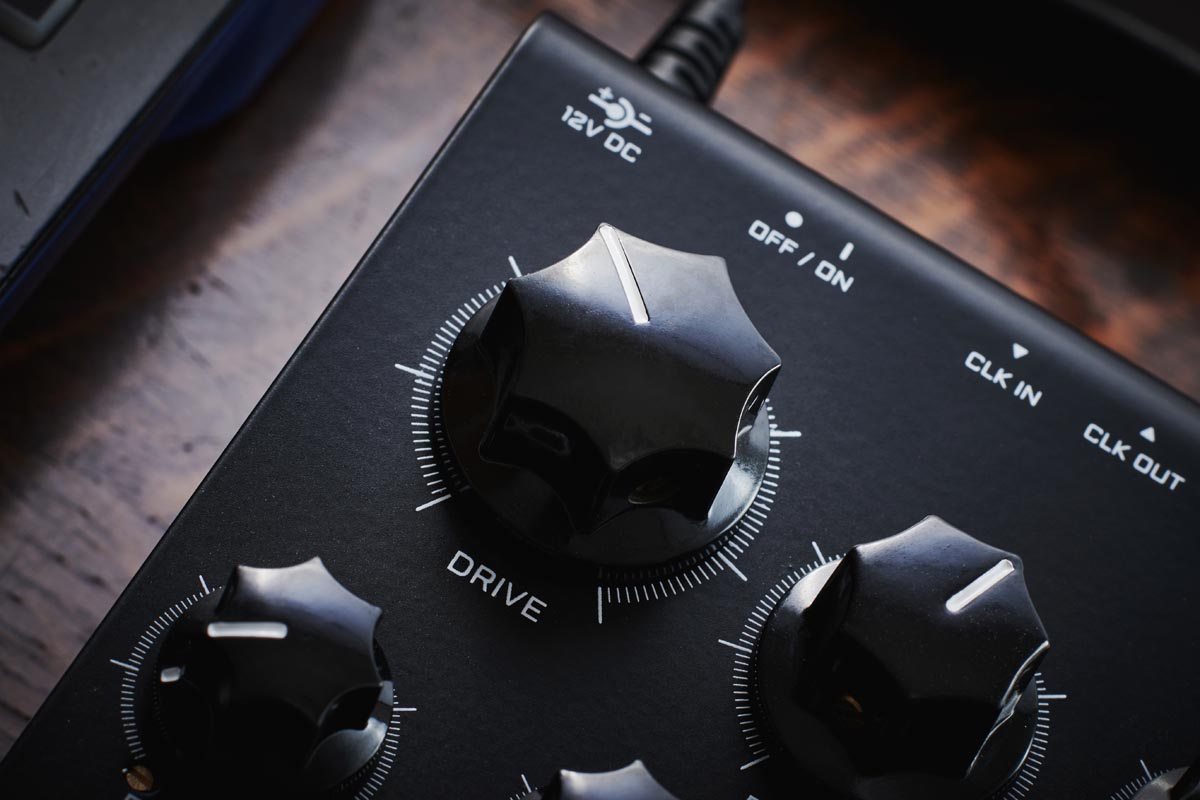
DRIVE: Blends the raw signal with the overdriven one, great for adding extra harmonic weight .
The modulation track lets users program CV changes to the cutoff position for each step. Like with sequencing notes, this can either be input step-by-step or recorded live by hitting record and tweaking the cutoff knob.
Any sequenced modulation works in conjunction with the other modulation inputs and in relation to the current position of the cutoff rotary, meaning it’s possible to, for example, program a modulated cutoff pattern, while also slowly modulating the overall cutoff level with the LFO, or manually.
An overall modulation depth rotary affects the cutoff modulation coming from all sources.
Randomisation
The final tool in the sequencing sequencer pitch/gate is a well-equipped randomisation tool. This allows users to randomise elements of their pattern based around set conditions – ie, just note, just modulation – and, in some cases within a preset range. It’s another string to the DB-01’s bow that makes it a deceptively deep and flexible creative tool.
Performance and Verdict
Hardware-wise, along with its primary 1/4 inch audio output, the DB-01 has multiple CV ins and outs. There are inputs for pitch, gate, modulation and clock, as well as outputs from the clock and sequencer pitch/gate. There are also standard MIDI in and out ports rounding things off.
Overall, the Bassline DB-01 is an excellent little bass machine that more than lives up to our expectations. Sound engine-wise, the marriage of analogue oscillators, Polivoks filter and gritty detune and drive make this an absolute beast when it comes to full, gritty bass and lead sounds.
If we’re being picky there are a few minor gripes: for one thing, the master volume is hidden in the settings menu, which is a bit fiddly, particularly since the drive and resonance can make levels ramp up pretty quickly. I would have liked to be able to set different sequence lengths for the note and modulation tracks too, to achieve polyphonic filter movement.
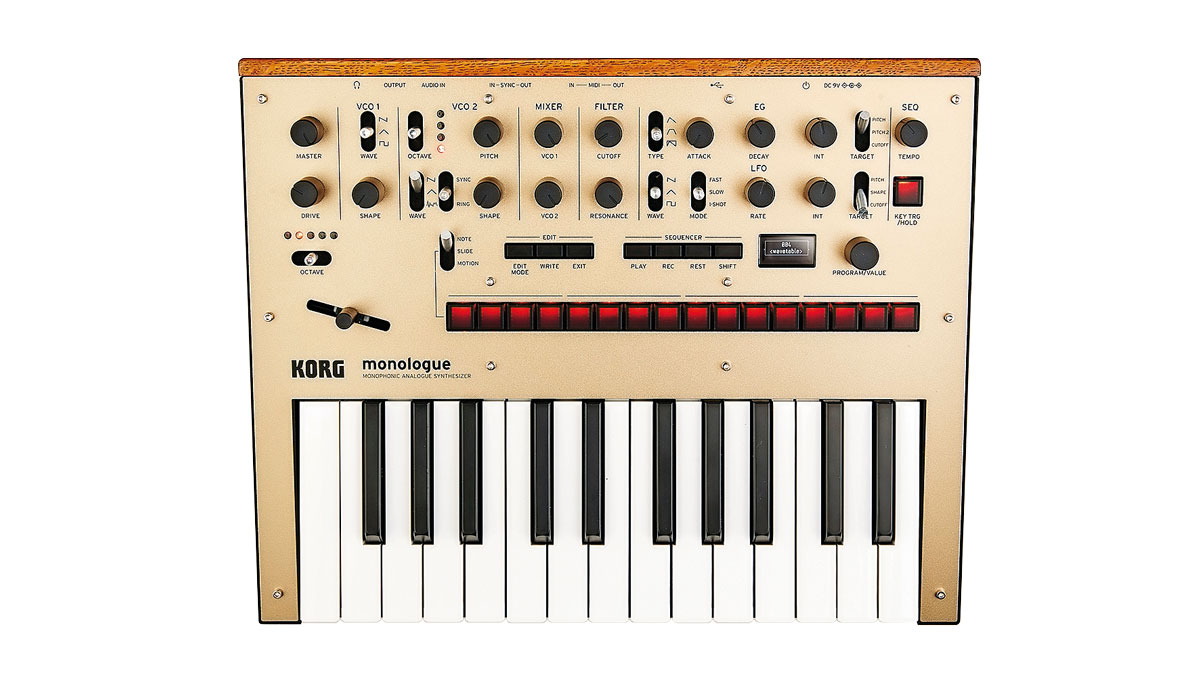
• Korg Monologue
A simpler monosynth than the DB-01, Korg’s Monologue also packs a sequencer with microtonal capabilities.
• Arturia MiniBrute 2
The MiniBrute 2 is an impressive analogue synth and a real step up from its predecessor. The patchbay adds flexibility and character that make this a very serious competitor in the now crowded analogue monosynth market.
As it stands, the Last Step tool lets users change sequence lengths on the fly, but the modulation and note track lengths are always linked. Finally, it’s a bit of a shame there’s no audio input included too, since it would really add to the instrument’s appeal if you could run external sounds through that excellent filter and drive circuit.
These are pretty minor complaints and feature requests though, none of which detract from the fact that this is one of the best specialist bass synths going. It doesn’t come cheap, relatively speaking, but the deceptively deep sequencer and top-notch sound should more than justify the purchase for you.
MusicRadar verdict: A powerful sequencer and plenty of unique features make this much more than just another Bassline-clone.
The Web Says
"Don’t be surprised if the DB-01 is taken up as readily as the 303 was by Chicago’s bedroom producers. This may become something of a modern classic. It’s well built, with solid Moog-style pots and a squat aluminium chassis that could surely withstand a barrage of hits."
MusicTech
Hands-on demos
Erica Synths
Ricky Tinez
Bonedo Synthesizers
Perfect Circuit
Specifications
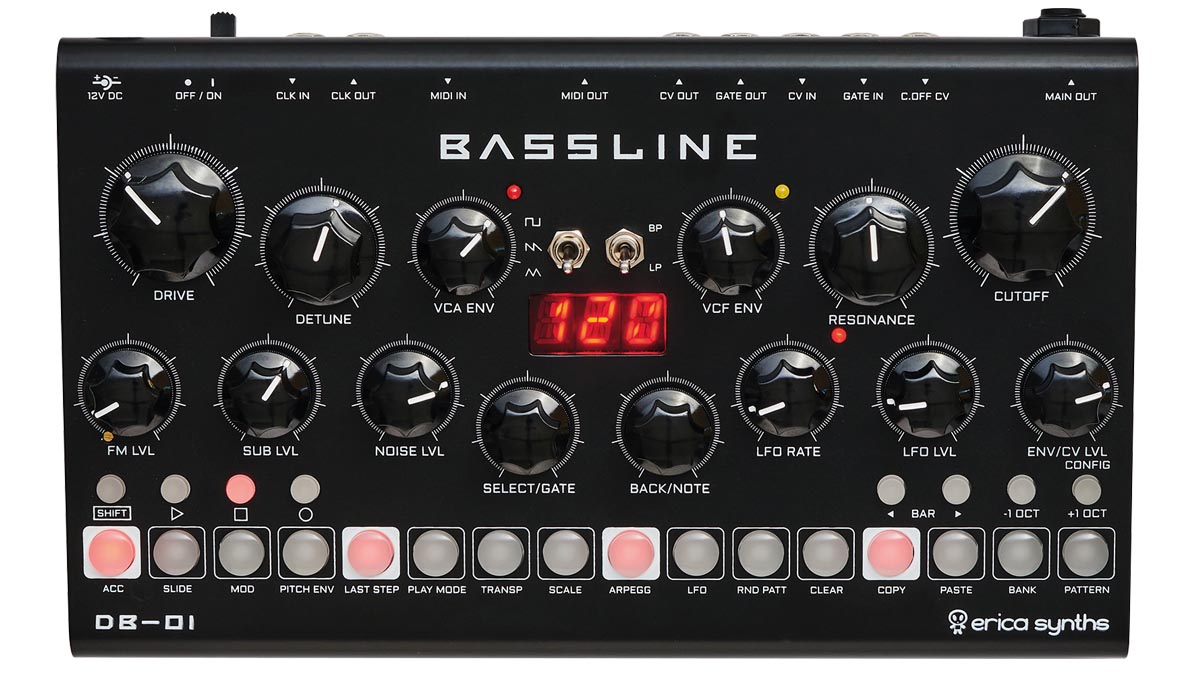
- Type: Desktop analogue synth with sequencer
- Key Features: Analogue monosynth with Polivoks-inspired filter, analogue drive and BBD detune effect. 64-step sequencer with arp, modulation track, slides, accents and per-step pitch envelope
- Contact: Erica Synths
I'm the Managing Editor of Music Technology at MusicRadar and former Editor-in-Chief of Future Music, Computer Music and Electronic Musician. I've been messing around with music tech in various forms for over two decades. I've also spent the last 10 years forgetting how to play guitar. Find me in the chillout room at raves complaining that it's past my bedtime.
"I said, “What’s that?” and they said, “It’s what Quincy Jones and Bruce Swedien use on all the Michael Jackson records": Steve Levine reminisces on 50 years in the industry and where it’s heading next
“Excels at unique modulated timbres, atonal drones and microtonal sequences that reinvent themselves each time you dare to touch the synth”: Soma Laboratories Lyra-4 review
“I used everything I knew about music”: How Green Day exceeded expectations with their most ambitious song
